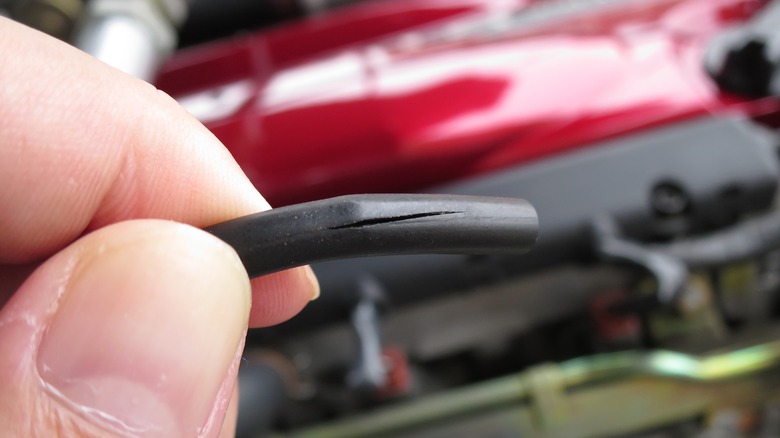How To Check Your Vehicle Engine For Vacuum Leaks
In my 35-plus years of working on cars, I have encountered nearly every frustrating troubleshooting problem in the book. Part of the issue stems from my affinity for old Jeeps and classic cars, which tend to generate more problems due to the deterioration of decades-old rubber gaskets, seals, and hoses. While it's usually easy to locate an oil or coolant leak thanks to the drip, stream, or fountain of liquid coming from said leak, finding vacuum leaks can be a less straightforward process.
The vacuum pressure produced by the movement of the pistons in your engine is not only used to pull the fuel-air mixture into the cylinders via the intake valves. An array of hoses coming from the intake manifold distributes that vacuum to other parts of your car like the brake booster, distributor vacuum advance, and positive crankcase ventilation (PCV) and exhaust gas recirculation (EGR) valves.
A vacuum leak generally won't keep your engine from starting, but it can be one of the issues that activate that pesky "check engine" light on your dashboard. It could also cause other problems like a high idle or poor performance under load, like when accelerating or climbing a hill. Here are a few ways to identify where a vacuum leak is coming from and what you need to do to fix it.
Your eyes and ears are valuable tools for finding vacuum leaks
The simplest checks you can perform to find a suspected vacuum leak require only a little patience and tools that are permanently installed in your head. Visually inspect your vacuum hoses for cracks, and make sure both ends of all your hoses are seated properly. It's also helpful to start your engine and let it idle while you move your head around listening for a telltale high-pitched whistle. Of course, be careful of moving parts like accessory belts and your cooling fan. Make sure to also keep long hair tied back, and your hands out of the danger zone.
Unless you have a big vacuum leak, the noise may be washed out by the sounds of the engine, and it might be hard to detect it using your ears only. If that's the case, you can also try to pinch off some of your vacuum lines. This can help identify a leaky component like a brake booster or distributor vacuum advance.
Vacuum leaks can also come from a loose or cracked intake manifold. If you've recently removed the manifold, carburetor, or throttle body, it can be helpful to check the mounting bolts with a torque wrench like the ones available from Harbor Freight. This will tell you if the manifold is secured properly. If all the bolts are tightened evenly and to the manufacturer's specifications, pass a mirror around and under the manifold to check for cracks.
You can perform some advanced tests if a visual check reveals nothing
If you can't see or hear where your vacuum leak is coming from, there are a couple other tests you can do. Vacuum leaks that lead to excess air being pulled into the engine can be located using an unlit propane torch, a can of starter fluid, carburetor cleaner, or brake cleaner. All of these substances are combustible and — when they find their way into your engine through a vacuum leak — will make it idle faster and more smoothly than it does when it's sucking excess air in through the leak. WD-40, which has numerous other uses in car repair and maintenance, can also be used for this test. Because all of these substances are flammable, be careful not to spray them on hot exhaust manifolds or near battery terminals, which can arc and generate sparks.
As with any auto repair task, it's a good idea to have a chemical fire extinguisher or fire blanket handy in case of a mishap. There are less primitive ways to hunt down vacuum leaks as well. Snap-On's AC 6500 vacuum leak detector monitors the sounds coming from your engine and will beep faster as the probe is moved closer to a leak. You can frequently find used detectors on eBay, Facebook Marketplace, and other resale sites. The Mityvac Vacuum pump from Harbor Freight can also be used to find vacuum leaks.

